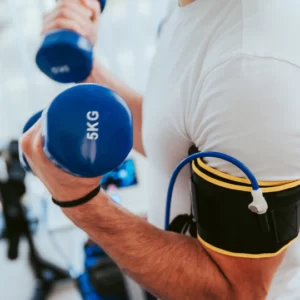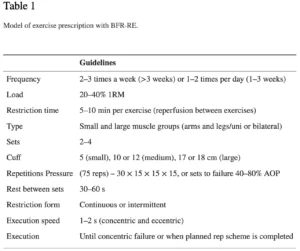BFR at a glance
Have you seen people in the gym with cuffs to restrain blood flow in arms or legs? It might seem crazy but could be useful for improve muscle size and strength with lighter weights.
Blood flow restriction (BFR) training, also known as occlusion training, is a type of exercise that involves restricting blood flow to the muscles during low-intensity strength training.

BFR training works by using a tourniquet or special cuff to occlude blood flow to the working muscles. This causes a decrease in oxygen delivery and an increase in metabolic stress, subsequently leading to muscle hypertrophy and strength gains (Patterson SD, et al. 2019).
BFR Mechanism
One of the main mechanisms behind BFR training is muscle oxygenation. During exercise, muscles need oxygen to produce energy. When oxygen delivery is restricted, as it is with BFR training, the muscles are forced to rely on other energy sources, such as glycogen and fatty acids. This leads to an increase in the production of metabolites, such as lactate, which can stimulate muscle growth (Patterson SD, et al. 2019).
BFR training is also thought to enhance post-exercise muscle adaptations, such as increased muscle protein synthesis, which is the process by which the body repairs and builds new muscle tissue.

But not everything is as easy as it sounds. You have to be careful to avoid inappropriate amount of pressure on the tourniquet or cuff. To perform BFR training safely, it is important to follow proper techniques, and it is also important to start with low-intensity exercises and gradually increase the intensity over time as the muscles become accustomed to the stimulus (Patterson SD, et al. 2019).
BFR Benefits
There are several scientifically proven benefits of BFR training:
- Rehabilitation after joint injuries: There are studies where blood flow restriction is suggested to augment strength and hypertrophy gains during the early phases of rehabilitation in patients with joint injuries. For example, a study made by Bobes Álvarez et al (2020), showed that pain significantly improved, and quadriceps strength increased in patients training with BFR after Cruciate Ligament Reconstruction or Knee Osteoarthritis.
- Hypertrophy and strength: There are studies that show that BFR and Resistance Exercise can increase skeletal muscle strength and/or hypertrophy in healthy young and older populations (Patterson SD, et al. 2019).
Important recommendations
I know BFR may sound like an undiscovered wonder… but wait a sec. It is super important to know when and how to do it properly. There are some risks that come with doing it without being careful:
- Venous thromboembolism: a thrombosis, a solid mass of platelets, red blood cells, and fibrin mesh that typically forms as a response to vessel wall injury and is part of the normal healing cascade. There is concern that thromboembolism could be formed from BFR. That’s why it is important to contact with a specialist that help you determine the best cuff size, compression, time and training to avoid any problems.
- Reactive Oxygen Species (ROS): ROS causes oxidative stress. Deflation of a tourniquet cuff is associated with an increase in ROS and has been directly associated with ischemic reperfusion injuries after orthopedic surgery. As we know from older articles, moderate exposure to ROS is necessary to induce adaptive antioxidant defense mechanisms, however, chronic or high levels of exposure have been linked to disease conditions and signaling to the blood coagulation system. So moderating BFR volume and counteracting ROS with diet and recovery sessions can reduce the risks of increased ROS and further cell damage.
In the following table, there are some guidelines to do BFR with Resistance Exercise. Remember, it is important to consult a professional trainer before starting any new training system.

Overall, BFR is a safe and effective way to improve muscle size and strength, as well as overall health and fitness. But remember that it is super important to consult with a qualified fitness professional to ensure that you are using proper technique and starting at an appropriate intensity level.













